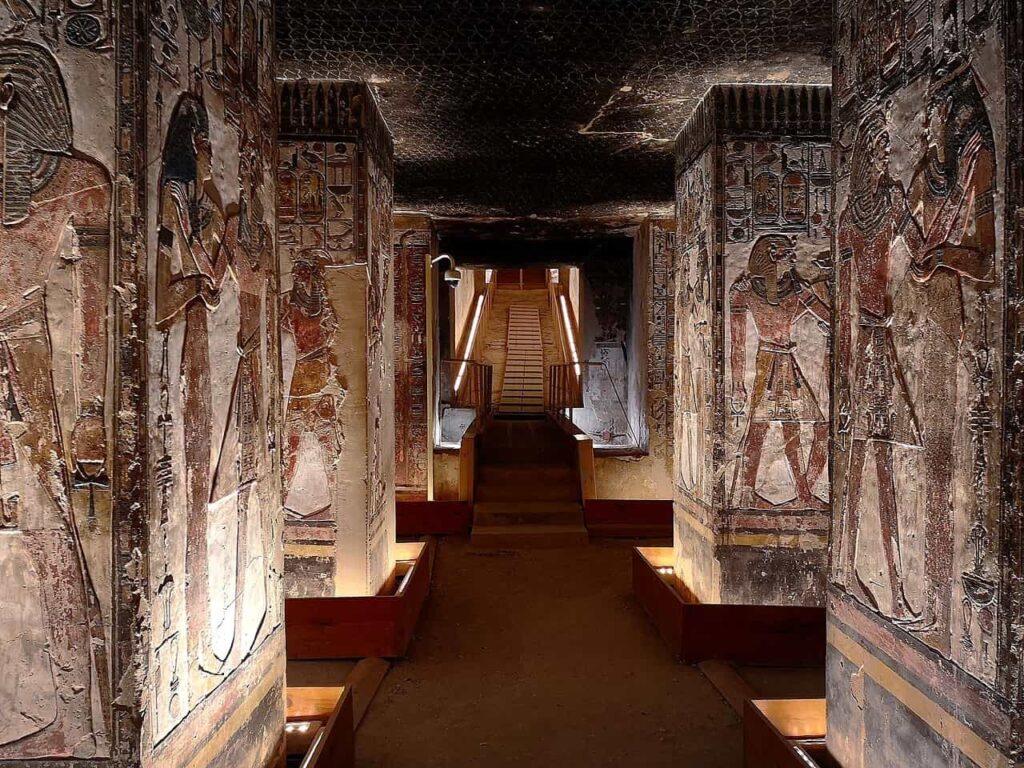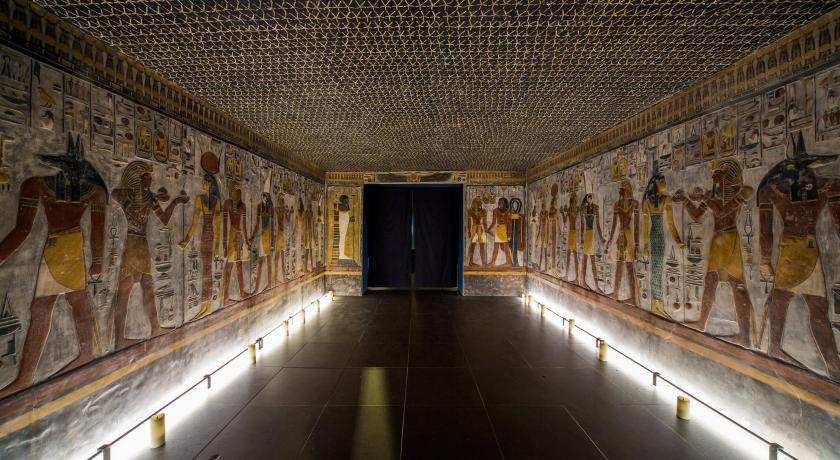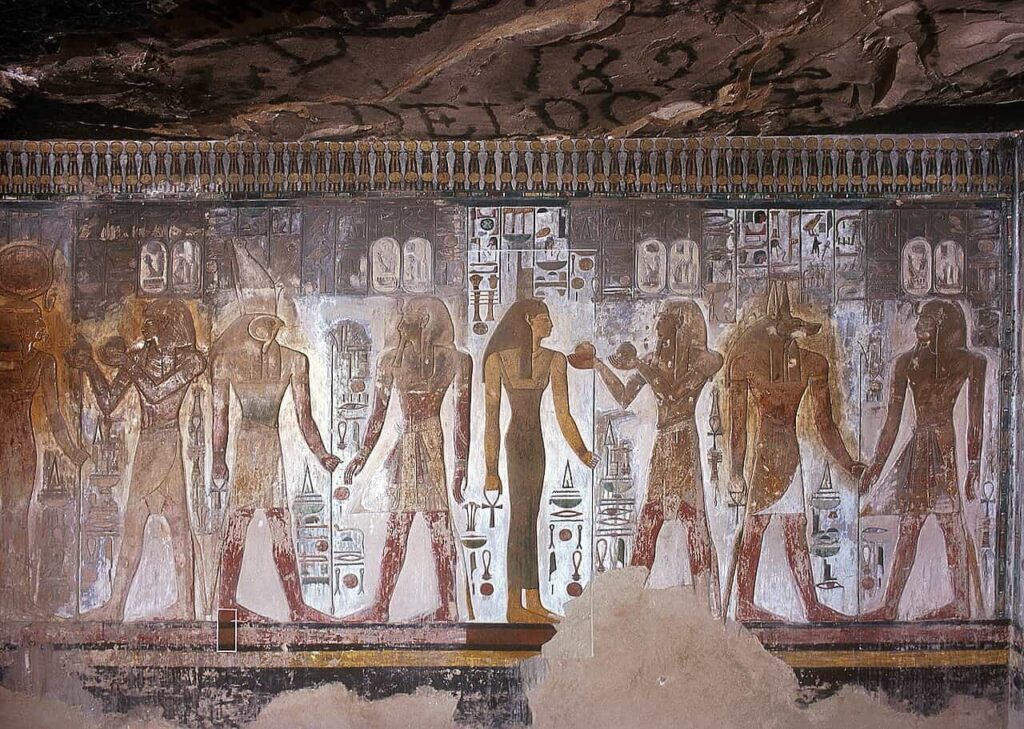KV17 is an Egyptian tomb situated in the Valley of the Kings, a necropolis located on the west bank of the Nile near the modern city of Luxor. It stands as one of the most beautiful and complete tombs in the area and belonged to the second king of the 19th dynasty, Pharaoh Seti I.
Historical Background
While the most common royal title of this king was Menmaatre Seti-Merenptah, today he is recognized as Seti I, reigning as the pharaoh of Egypt for approximately sixteen years, from 1305 to 1289 BC.
Initially not designated to ascend the throne of the Two Lands, Seti was propelled into the role of a mature crown prince when his father, the vizier Paramessu (Ramesses I), was associated with the throne by King Horemheb.
Upon Horemheb’s death, Paramessu (Ramesses I) was crowned and subsequently known as Ramesses I, becoming the founder of the 19th dynasty and the royal house of Ramesside.
Due to Seti’s advanced age, he was promptly declared heir, sharing the responsibilities of his father, akin to a situation of coregency. In under two years, Seti I assumed sole rule over an Egypt that was starting to respond to external pressures.
Seti I is revered as one of the greatest pharaohs in ancient Egyptian history, although the significant shadow cast by his son and successor, Ramesses II, has often eclipsed and downplayed some of his achievements as a king.
Credit goes to Seti I for initiating the construction of the splendid Temple of Osiris in the sacred city of Abydos, albeit its completion falling under Ramesses II’s tenure, and for setting in motion the policies his son steadfastly pursued.
Seti I engaged in battles against the Hittites’ allies, reaching as far as the fortress of Kadesh in Syria, fifteen years before his son’s similar campaign. He instituted firm control over administration and the military, leaving behind an Egypt that had fully recovered from the tumultuous reign of Akhenaten.
The tomb of Pharaoh Seti I, also known as KV17
KV17 stands as the longest and deepest tomb not just within the Valley of the Kings but within the entire Theban necropolis and Egypt as a whole. Its immense size took considerable time to be fully explored and understood.
Situated in the southeast of the Valley, it stands adjacent to KV16, the tomb of Ramses I. Due to its extensive dimensions, the tomb of Seti I connects, via its elaborate floor plan, with several other royal tombs situated further away.
While KV17 may be smaller in terms of area compared to other tombs like KV5 or KV7, it boasts seven corridors and ten chambers along its entire length, requiring extensive and laborious excavation.
All these chambers, except for the final corridor, are richly and extensively adorned, suggesting that construction of the tomb likely commenced shortly after Seti I ascended the throne or even during the reign of Ramses I.
KV17, alongside KV5, possibly presented the most significant architectural and technical challenges to the builders of Deir el-Medina throughout the history of the Theban necropolis.
The layout of Seti I’s tomb follows a design very similar to that of Horemheb’s tomb, which subsequent rulers would later emulate with minor alterations.
The entrance comprises a staircase followed by three descending corridors (one staircase and two ramps) exhibiting a noticeable incline and a width exceeding two and a half meters.
Beyond these corridors lies the funerary shaft—KV17 being one of the last tombs to feature it—subsequently leading to the traditional pillar room. This room, housing four columns, includes an adjoining chamber with two additional pillars of almost identical size, aligning with the tomb’s axis, apart from a descending staircase hinting at depths within the earth.
Continuing along this staircase leads to the two intermediate corridors, designed as a ramp, except for the initial six steps at the entrance, which guide to the antechamber of the tomb known as room I. This chamber is smaller compared to the two pillar chambers, and beyond it lies the crypt or sepulchral chamber, serving as the heart of KV17.
The crypt is divided into two primary parts: one section featuring six pillars and small chambers on each side, while another segment, separated by steps, presents a vaulted ceiling—marking the first instance of a vaulted ceiling in a crypt, intended as the resting place for the deceased’s body.
Upon entry, on the right side of the sarcophagus, a new room emerges, hosting two large pillars with a similar area as the other rooms. To the left stands a smaller annex, while directly ahead lies an elongated room housing four columns in a row.
Beneath this area lies the most enigmatic and extensively studied section of KV17—corridor K. This narrow and irregularly shaped corridor continues its descent, featuring a substantial slope that extends for several more meters. The purpose of this structure, unique to a tomb of this magnitude, remained a mystery for a long time, given its considerable depth, seemingly leading to no specific destination.
Investigation into this area commenced in 2007, clearing it of rubble and revealing a new flight of stairs. Another corridor emerged, culminating in a door where the architect had inscribed “Raise the door jamb and widen the passage” on the right jamb. Beyond this door lay 37 steps of another staircase, the latter half being partly carved. It became apparent that work had ceased abruptly upon the news of the pharaoh’s demise, with excavation halting at a distance of 174.5 meters from the tomb’s entrance.










